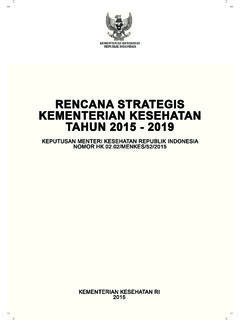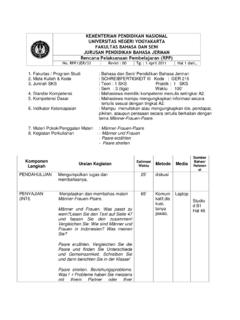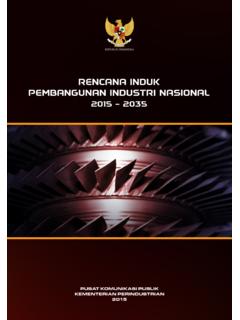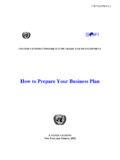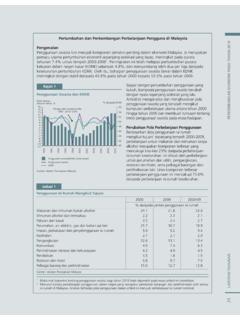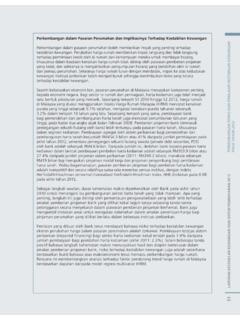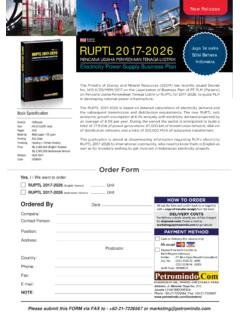Transcription of Assessment and Action PlanREPORT 1
1 Emily Lloyd, CommissionerREPORT 1A Report Based on the Ongoing Work of the DEP Climate Change Task ForceAssessment and Action PlanMAY 2008 The New York City Department of Environmental ProtectionCLIMATE CHANGE PROGRAMA cknowledgmentsThis Report presents the initial steps that the New York City Department ofEnvironmental Protection (DEP) has taken over the past four years toaddress climate change. The Report includes the findings and recommen-dations to date of DEP's Climate Change Program and Task Force and theimmediate actions that DEP is committed to undertaking to further addressthis critical issue. The policy and program recommendations of the Reportare those of LicataDeputy CommissionerGary C. HeathDirector of Bureau Operations DEP wishes to thank the New York CityWater Board for its support of DEP'sClimate Change Program.
2 The approxi-mately $ million in funding from theBoard has allowed DEP to establish astrong foundation on which to build a com-prehensive long-term strategy for address-ing the challenges of climate 's Bureau of Environmental Planningand Analysis, as the leader of DEP'sClimate Change Program, wishes toacknowledge and thank the members ofthe DEP Climate Change Task Force fortheir dedication, invaluable expertise, andextensive contributions to this and involvement throughoutDEP helped us meet our primary goals ofinterdisciplinary awareness of and attentionto climate change issues. The Task Forcemembers include representatives from allDEP Bureaus as well as participants fromoutside the Department: the ColumbiaUniversity Center for Climate SystemsResearch, the NASA Goddard Institute forSpace Studies, HydroQual EnvironmentalEngineers & Scientists, , the New YorkCity Office of Environmental Coordination,the Mayor's Office of Long-term Planningand Sustainability and the New York CityLaw of ContentsAcknowledgments1 Foreword3 Executive Summary41.
3 Climate Change Science, Observations and Science of Climate Global and Regional Climate Global and Regional Climate Model Uncertainty and Scientific Uncertainty and the DEP Actions to Reduce Uncertainty in Regional Climate Change Trends292. Potential Climate Change Impacts on Potential Impacts to the Water Supply Potential Impacts to the Drainage and Wastewater Other Impacts to DEP Actions to Enhance Its Understanding of the Potential Impacts of Climate Change on DEP443. Potential Adaptation Strategies for Potential Water Supply Adaptation Potential Drainage and Wastewater Adaptation Uncertainty and Planning for System DEP Actions to Determine and Implement System Adaptations614. Greenhouse Gas Emissions and Mitigation at City of New York Commitments to Greenhouse Gas Emissions DEP Greenhouse Gas Establishing a DEP Greenhouse Gas Emissions Establishing a DEP Greenhouse Gas Management City of New York Litigation Initiatives to Curb Greenhouse Gas DEP Actions to Inventory and Reduce Greenhouse Gas Emissions755.
4 Potential Impacts and Adaptations Summary786. Climate Change Action Plan 84 Appendix 1 Contributors91 Appendix 2 Acronyms and Abbreviations93 Appendix 3 Glossary of Terms94 Appendix 4 References98 Contact Information100 REPORT 1 Assessment AND Action PLANThe New York City Department of Environmental ProtectionCLIMATE CHANGE PROGRAM2 Emily LloydCommissioner, NYCDEP The impacts of climate change will be pervasiveand profound. Most natural and man-made sys-tems will be affected, and the City of New York'swater supply, drainage, and wastewater man-agement systems are no exception. To over-come the challengesof climate change, asstewards of the City'swater systems, we atthe New York CityDepartment of Envi-ronmental Protectionare placing ourresponse to climatechange at the core ofour strategic andcapital planning.
5 ThisReport is the first in a series of reports that pres-ents the many steps that the Department hasalready taken to address climate change, and itoutlines the Department's initial plan of Action forcontinuing to confront the most critical environ-mental issue of our time. In future reports wehope to chronicle our essence, the Department's plan is to adaptthe City's water systems to withstand climatechanges in the City and upstate watershed whilesimultaneously striving to help minimize thosechanges. First, I am working with the Depart-ment's highly-skilled planners, engineers, andoperators to adapt our infrastructure so that theCity is able to continue to provide water servicesto New Yorkers even as changes occur to tem-peratures, rainfall patterns, snowpack, stormintensity, and sea level.
6 Successful adaptationwill require that we rethink our traditionalapproach of designing infrastructure based onthe weather patterns and sea level experiencedin the past, and move towards a new approachof risk-based design for the range of climateconditions projected for the future. Thesechanges can also help to improve our systemsresiliency to current weather extremes. Second,we are working to reduce the Department'sgreenhouse gas emissions by incorporatingprocess improvements, energy efficiency, andrenewable energy into facility Department's response to climate changecomplements the goals of PlaNYC, MayorMichael Bloomberg's plan for a greener, greater,sustainable New York. Integral to PlaNYC is astrategy for reducing water demand, preservingthe first-rate quality of our drinking water, main-taining our City's water infrastructure, andimproving the water quality of New York City'sgreat harbor.
7 The Department's Climate ChangeProgram will help the City achieve these PlaNYCgoals, and implementation of PlaNYC will makethe City's water systems more resilient, thushelping the Department to ensure the reliability ofvital water services despite the pressures of achanging climate. Furthermore, to assist theglobal community in slowing the pace of climatechange, PlaNYC aims to reduce New York Citygovernment greenhouse gas emissions by 30%by 2017. The Department, which is responsiblefor 17% of total City government emissions, iscommitted to reducing its emissions to help theMayor achieve this climate change will prove issues are new and complex, the timing andextent of change is uncertain, and modifyinglarge-scale infrastructure systems is expensiveand takes time.
8 But with careful planning, we cansucceed. The Department is committed to mini-mizing climate change risk, we have the supportof our visionary Mayor, and we will not be tack-ling the issue alone; we are cooperating withother water agencies and utilities, both national-ly and internationally, to share knowledge andspur innovation. The Department has alreadymade significant progress, but there is still muchto do and the time to take Action is New York City Department of Environmental ProtectionCLIMATE CHANGE PROGRAMBy Emily Lloyd 3 The Earth is warming. Atmospheric andoceanic temperatures are rising, and exten-sive scientific modeling predicts more dra-matic increases into the future. As thesetrends accelerate, sea level will rise, and amore volatile climate with unpredictable pre-cipitation patterns and more intense stormswill be likely.
9 In order to effectively anticipateand confront these climatic shifts, policy-makers must begin to act gas (GHG) emissions must berigorously identified and cataloged. Compre-hensive plans for emissions reductions mustbe developed and implemented. And poten-tial risks must be identified and addressed sothat essential services can continue to beprovided as the climate recognition of this charge, the New YorkCity Department of Environmental Protection(DEP or the Department), which is responsi-ble for providing water supply, drainage, andwastewater management services to millionsof New Yorkers, has developed a compre-hensive Climate Change Program. Throughthis program, DEP works closely with leadingscientists and engineers to project regionalclimate changes; assesses the impacts of awarming Earth on New York City's water sys-tems; and identifies opportunities for mean-ingful on this work, and in accordance withPlaNYC, Mayor Michael Bloomberg's plan fora sustainable City, DEP has begun to imple-ment many programs that address global cli-mate change and its projected impacts onNew York City's drinking water delivery,stormwater management and wastewatertreatment systems.
10 The following Reportsummarizes this substantial process ofanalysis and Action and outlines a compre-hensive adaptation strategy for DEP as it pre-pares for a warmer and more volatile SummaryClimate change must be consid-ered in all short-term and long-term infrastructure and policyplanning initiatives. REPORT 1 Assessment AND Action PLAN4 The impacts of climate change willbe pervasive and profound. Mostnatural and man-made systems willbe affected, and the City of NewYork s water supply, drainage, andwastewater management systemsare no time to takeaction is now. Emily Lloyd Commissioner, NYCDEPES1A CONTEXT FOR Action : CLIMATE CHANGE SCIENCE5ES1A Context for Action : Climate Change Science>99% Virtually certain that there will be warmer and more fre-quent hot days and nights over most land areas>90%Very likely that there will be more warm spells, heatwaves, and heavy precipitation events over most areas>66%Likely that there will be increases in drought-strickenareas, more intense hurricane activity, and an increasedincidence of extreme high sea levelThe Intergovernmental Panel on Climate Change (IPCC) statesthat on a global scale during the 21st century, it is.










